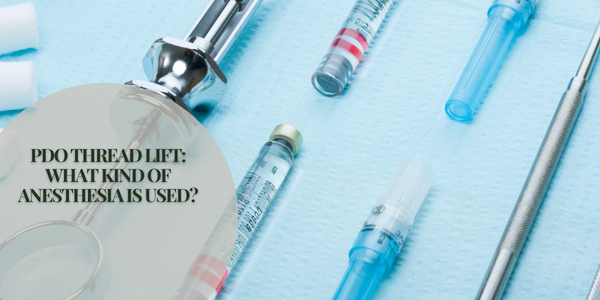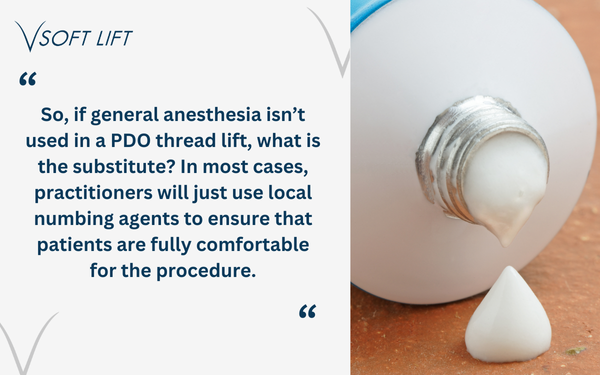
PDO thread lifts are valued for the amazing results they produce and the fact that they are considered minimally-invasive procedures. In most cases, these treatments take less than an hour to complete and don’t require significant downtime and recovery time like traditional surgery does.
Despite the short amount of time that they take to complete, PDO thread lifts produce amazing results that mimic old-fashioned facelifts. And while the results aren’t permanent, the procedures can be repeated whenever you want to achieve your desired results.
One of the main benefits of a PDO thread lift is that they don’t require general anesthesia, since there is no surgery involved. Instead, there are other less-invasive things that can be done to make patients comfortable during the procedure.
In this article, we’ll explore whether PDO thread lifts require anesthesia, and what other products are used to make patients feel comfortable.
Simply put, no — a PDO thread lift doesn’t require general anesthesia1. Patients do not need to be “put under” for this type of procedure, since they are not undergoing surgery of any kind.
 Medically reviewed by: Elizabeth Williams RN
Medically reviewed by: Elizabeth Williams RN
Updated: 4/30/2025
Does a PDO Thread Lift Require General Anesthesia?
Simply put, no — a PDO thread lift doesn’t require general anesthesia1. Patients do not need to be “put under” for this type of procedure, since they are not undergoing surgery of any kind.
Instead, a trained practitioner is inserting thin threads into your skin using a preloaded cannula. In a lot of ways, this is similar to how an IV line is inserted into your body.
Once the PDO threads have been inserted into your skin, your provider will position them perfectly to achieve the results that you are looking for. This part of the procedure could be painful if no other medicine or agents were used, which is why you’ll likely receive an injection before it begins.
| Aspect | General Anesthesia | Local Anesthesia (Used in PDO Thread Lifts) |
|---|---|---|
| Type of Procedure | Used for major surgical procedures | Used for minimally-invasive treatments |
| Patient State | Fully unconscious | Fully awake and alert |
| Method of Administration | IV or inhalation | Topical or injected lidocaine (with or without epinephrine) |
| Recovery Time | Several hours to days | Minimal; resume daily activities shortly after |
| Associated Risks | Higher (e.g., breathing complications, nausea) | Lower (mostly mild discomfort or temporary numbness) |
What Medicines Are Used in Place of General Anesthesia for PDO Thread Lifts?
So, if general anesthesia isn’t used in a PDO thread lift, what is the substitute? In most cases, practitioners will just use local numbing agents to ensure that patients are fully comfortable for the procedure2.

The most commonly-used local anesthesia is 1% lidocaine3, and it also might include epinephrine. This local anesthesia can be injected into your skin at the same place where the PDO threads are going to be inserted.
Sometimes, your practitioner might use a cream version of this local anesthesia4, but either way, the purpose is the same — to ensure that you are fully comfortable for your PDO thread lift.
After the local anesthesia has been injected or applied, you will likely wait a bit to ensure you are sufficiently numb. Then, the practitioner can begin the procedure, during which you shouldn’t feel any pain at all5, but might feel some slight tugging and/or pressure while they’re positioning the PDO threads.
| Component | Purpose | Notes |
|---|---|---|
| 1% Lidocaine | Local anesthetic to numb treatment area | Often injected, sometimes combined with epinephrine |
| Epinephrine | Reduces bleeding and prolongs lidocaine effect | Used selectively based on patient need |
| Topical Numbing Cream | Initial surface numbing | May be used before lidocaine injection |
| PDO Threads | Lift and stimulate collagen in skin | Barbed or smooth, absorbed over time |
| Preloaded Cannula | Device to insert threads safely | Minimizes trauma to surrounding tissues |
What Does a PDO Thread Lift Entail?
A consultation and numbing the area are the first two steps of any PDO thread lift. Then, comes the actual insertion of the threads and the positioning of them in your face.
For a lift procedure, your practitioner will likely use PDO threads with barbs on the ends of them. These barbs are meant to grab onto parts of your skin and lift them up to a new position, which ultimately mimics the results of a traditional facelift.
Your practitioner will insert these PDO threads into your skin, position them in the right way to achieve your desired results, ensure that everything is symmetrical, and then snip off the ends so no threads are protruding out of your skin.
And just like that, the procedure will be complete.
You will be able to resume most of your daily activities as soon as you leave the office, though you should avoid some medications, strenuous activities, and deep facial cleansing or massages for a few weeks.
With a PDO thread lift, you’ll be able to see some of the results immediately, due to the threads lifting your skin. Those results will only get better over time, as your body produces extra collagen in the area to help break down the threads naturally.
This collagen will not only enhance the results of your procedure, but will add elasticity and shininess to your skin, giving you that youthful, natural look you were going for.
V Soft Lift’s High-Quality Threads Produce Amazing Results
A major reason why people love PDO thread lifts is the fact that you only need local anesthesia to ensure you are comfortable during the procedure. These local numbing agents should ensure that you feel no pain during your procedure, only a slight tugging or pressure.
It’s very important to choose a provider who is experienced at PDO thread procedures and who is considered reputable in the field. It’s equally as important to ensure they use high-quality PDO threads, such as those produced by V Soft Lift.
We create top-of-the-line PDO threads that can be used in all different types of procedures. We even have specific threads that can be used for different treatment areas or skin types, ensuring you get the best results possible.
For more information, contact us today.
References
- https://my.clevelandclinic.org/health/treatments/24581-thread-lift#:~:text=A%20thread%20lift%20doesn’t,don’t%20feel%20any%20pain.
- https://www.utphysicians.com/thread-lift/#:~:text=Local%20anesthesia%20(lidocaine)%20is%20used,patients%20who%20have%20busy%20schedules.
- https://www.ncbi.nlm.nih.gov/books/NBK539881/
- https://www.ncbi.nlm.nih.gov/books/NBK430894/
- https://my.clevelandclinic.org/health/treatments/24581-thread-lift
